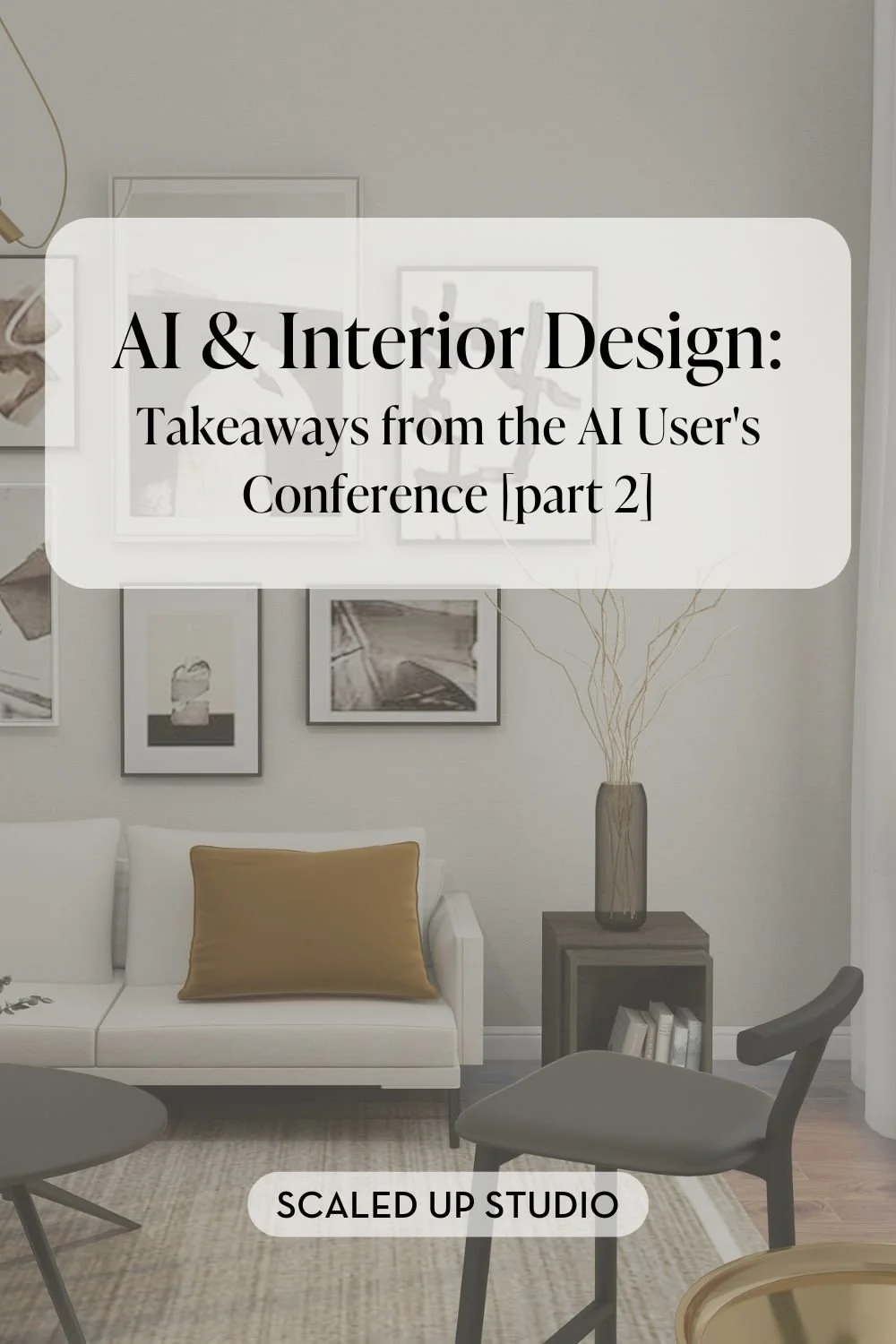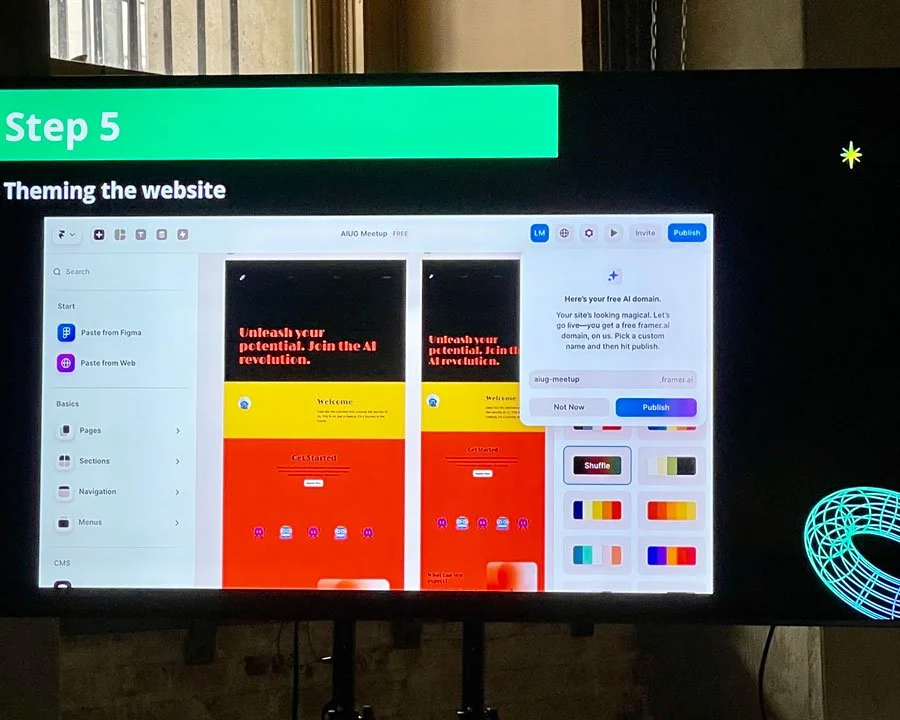AI & Interior Design: Takeaways from the AI User Conference [part 2]
Missed part one? See this post.
"AI does not have taste."
This out of the mouth of a presenter at the A.I. User Conference I attended recently while he was demoing how to create an AI-generated website.
"Finally somebody said it." was the thought bubble floating over my head.
Over the last day and a half, I'd witnessed demo after demo of AI startup technology. Text-prompted images and videos were the bulk of it.
Throughout, the recurring theme for me was: 'This has limited applicability right now for me (as a website and marketing creator for designers) since most of it's not exactlyyyy aesthetically pleasing.'
Which led me to evaluate the big-picture question:
At this time, how much of a threat is AI to interior designers and how helpful is it?
First, what’s “generative” AI?
Generative AI software creates images, text, video, and software code based on user prompts. In contrast, Predictive AI uses large data repositories to recognize patterns to suggest predictions and future trends. eweek
Generative AI is what we’re talking about here, and the generative AI that I encountered will not be replacing designers, either interior or website/marketing like me, any time soon.
Right now, most of the “out of the box” offerings are aimed at corporate brands in need of marketing assets.
For example, if you're in the U.S., think of your standard pharmaceutical ad (pharma ads are a big no-no most other places) of an energetic person/couple/family doing things like walking through a sunny field / hiking a mountain / enjoying a view etc. while the benefits of the wonder drug are voiced-over in the background (and the potential side effects are rattled off at the end like a cattle auctioneer).
You get the picture. The AI I saw over the last couple days is pretty darn amazing at generating images and videos to support a product/service like this, which is why they demoed just such an ad during the conference.
This generative AI can be tremendously helpful for so many companies and businesses. However, interior design and architecture is all about the aesthetic itself.
We take a unique space or site and create a unique design. Then we have to communicate all the specifics about that design to all the clients and stakeholders so it can eventually be successfully built.
But what about the fantastic(al) Midjourney rendering?
Let’s take a step back. We ALL know “the rendering” is only one sliver of the entire design project.
It is an important communication and sales tool for sure. However, it’s one small part of a much larger design process. Do I recommend you get acquainted with Midjourney so you can use it to create conceptual design imagery? Yes I do.
(Click here to join the AI for Interior Design waitlist.)
AI for marketing an interior design business
Social Media
Even “whipping up an Instagram reel in 5 minutes” that includes on-brand visuals with AI isn’t realistic for most designers. (Despite what’s promised by a lot of free webinars right now...) We need the imagery or video clips from the current/past/whatever project, the on-brand fonts and colors etc., not generic corporate visuals.
The AI can absolutely help get us there faster by generating content ideas and copy. However, most of the visuals, video especially, we still have to produce ourselves.
This will change fairly quickly though.
Training your own GPTs
My takeaway after attending both the AI for Marketers and AI for Designers days of the AI User Conference is that AI is an amazing tool to help interior designers streamline their behind-the-scenes workflows, from emails and SOPs to website and social media content.
Especially through building your own GPTs.
A “GPT” is what OpenAI calls custom versions of ChatGPT. You can create your own GPTs for specific purposes by using a combination of instructions, additional knowledge, and a combination of skills.
Your GPT is essentially a template you’ve created for what you want. You’ll save it, and then each time you need it, you’ll tweak the variables for your new project.
Custom GPTs are one of the most powerful ways designers and architects can deploy AI in their businesses.
The day won’t be far off where just as you can easily train AI to mimic your brand voice and style to write copy, it will be able to generate video visuals that are on brand for you.
It can be done now in some form, but it’s not widely available nor is it up to the standards required by interior designers, architects, and other home design professionals.
Let’s see how quickly this post ages, shall we?! 😅
AI Website Design for interior designers
Back to the presenter: “AI does not have taste."
To be fair, I'm taking his words out of context. He is a big fan of Framer.com, the AI website generator he was demoing.
His real point was the importance of crafting a quality prompt. Indeed, if you've done any experimenting with ChatGPT or other AI software, you quickly realize the old adage of "garbage in, garbage out" holds true.
You must have a quality prompt.
It doesn’t matter if you’re using ChatGPT to help you write your website copy or using Framer.com to create the website itself. If you don’t know how to set up the system with quality prompts, you’re going to be seriously underwhelmed with the results.
Did AI just discover Squarespace?
On the projection screens around the room, we watched the presenter enter prompts with specific attributes he wanted for his demo website.
When he was done, he pressed a button and we all sat back. Framer groaned and churned against the wildly inadequate WIFI allotted for the conference, (it was a serious on-going issue) but it eventually created a website.
It was a colorful version of a basic 5-page website. It was by no means ready to be published live out to the world, but it was a website.
Creating an AI generated website with Framer at the AI User Conference in San Francisco.
What if you don't like what you see?
You hit Refresh and it will offer up another version of the website.
How does it do this?
Well, not the way I expected. When I first heard about AI generated websites, I thought these new platforms would have the entire webby metaverse to draw from for website design inspo. And so I really was a bit concerned about “the robots” coming for my job. 🤖
Then the presenter said the Framer platform is based on a template database. Keep refreshing and eventually it will cycle back to the same templates.
He then likened Framer to the “Canva affect”, meaning Framer isn’t pulling unique ideas for your site based on the planet’s supply of beautiful websites. It’s using an internal database of website templates, similarly to how Canva offers up design using their own template database.
“Ummm, so this ‘AI solution to website building’ is to create another template-based web builder platform? You mean like Squarespace?” — the new snarky thought bubble floating over my head.
If you aren’t familiar, Squarespace and a few other website-building platforms come with templates you can use for building your website.
You don't have to use one. You can build your site from a blank template, but most people will peruse Squarespace's free templates or better yet, purchase one strategically optimized for their type of business so they can launch stronger and faster. (This is the type of template I’ve created for interior designers.)
So I have to admit, I felt a bit deflated to learn that’s the backbone of the software, but also elated because Squarespace does it much, much better.
Framer:
Want to insert your brand assets? You have to import a Style Guide you’ve created in Figma first. They aren’t stored natively on the platform like Squarespace.
There’s a free version but you have to use their own URL. A custom domain requires a paid plan.
Support is limited but there is a Framer community where you can clone other pages.
“Framer’s also automatically mobile-responsive, and it integrates with Typeform and Calendly!” crowed the speaker.
‘Yeah, we got that covered already and have for a long time, plus about a zillion other fully supported integrations.” - final snarky Tina thought bubble.
Including a setting that prevents your content from being usurped into AI databases. No other platform has that.
So yes, I may be a bit biased, but it seems like other website building platforms are coming around to the Squarespace model of the all-in-one content management system, or CMS, where with a single subscription you can make a website, host your content, register your own custom domain name, sell products, track your analytics etc.
From Elementor, finally responding to the tear-your-hair-out hassles of dealing with traditional WordPress, or now Framer’s basic setup as well as other AI website-generator platforms, the CMS platforms are in high demand because they make running a small business through your website so easy.
(Click here to join the AI for Interior Design waitlist.)
Wrap up
In sum, attending the conference reaffirmed my conclusion from my previous post that indeed, AI isn’t going to displace either interior designers nor website marketers serving interior designers anytime soon. 😉
Will it change our jobs? Absolutely. I think AI will save us a lot of time marketing our businesses, with conceptual design, and even construction documents before too long. (More on that soon.)
But again, garbage in garbage out. AI still requires skillful human direction to work effectively in design.
What are your thoughts, observations, and concerns regarding artificial intelligence? Leave me a comment below.
Other home design professional business-building posts you’ll love:
Don’t forget to Pin it for later!
If you have any questions or comments, please drop me a note below. Be sure to check back for my response (I always respond) since no notification is sent.



